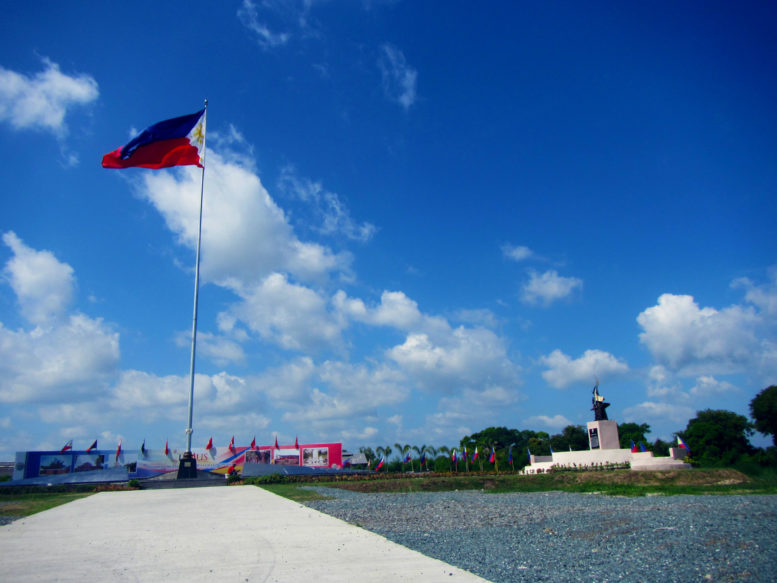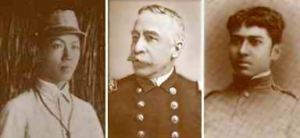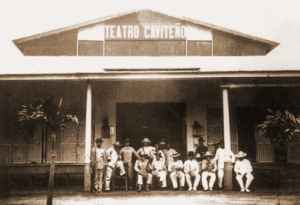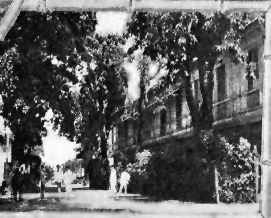Upon the invitation from the National Historical Commission of the Philippines’ (NHCP) Executive Director Ludovico Badoy, FVR was Guest of Honor and Speaker at the 118th Anniversary of the Battle of Alapan that transpired on 28 May 1898. The commemorative program was held at Dambana ng Pambansang Watawat (Shrine of the National Flag), Heritage Park, Miguel Santo, Alapan, Imus, Cavite.
The Battle of Alapan was the first big military victory of General Emilio Aguinaldo after his return to the Philippines from Hong Kong on 19 May 1898 aboard a U.S. vessel provided by Admiral George Dewey. After the American naval victory of the Battle of Manila Bay two weeks earlier, Aguinaldo returned from exile in Hong Kong, reconstituted the Philippine Revolutionary Army, gave orders for military offensives in Central Luzon and Tagalog provinces, and himself fought at close range against a garrison of Spanish troops in Alapan that lasted for five hours when the “Castilas” ran out of ammunition and surrendered to the Filipinos.
At nightfall after his victory at Alapan, Gen. Aguinaldo unfurled the new Philippine flag for the first time, marched to Cavite Puerto, and hoisted it in front of Filipino revolutionaries and captured Spanish troops. A group of American sailors of the U.S. Asiatic Squadron also witnessed the historic event.
The new Philippine flag, which Aguinaldo himself designed, had been sewn in Hong Kong by Marcela Agoncillo and her daughter with the help of Delfina Herbosa de Natividad, a niece of Jose Rizal. That was a glorious launching of our Philippine Flag in Cavite, in the presence of freedom-loving, hitherto, colonized peoples, and before the whole world!
Prelude To Aguinaldo’s Return
The previous year marked the end of the first part of the Philippine Revolution with the signing of the Pact of Biak-na-Bato in Bulacan. Under the terms of that agreement, Aguinaldo went into exile in Hong Kong. When Aguinaldo was in exile, the Spanish–American War began. Although most of the war’s battles took place in the Spanish colony of Cuba 12,000 miles away, the first major battle was between the Spanish and American Navies in the Battle of Manila Bay. On 01 May 1898, U.S. Navy Admiral George Dewey of the U.S. Asiatic Fleet engaged and defeated the Spanish Pacific squadron under Admiral Patricio Montojo. Soon thereafter, Aguinaldo, who at the time was visiting Singapore, returned to Hong Kong and sought Dewey’s help to return to the Philippines.
In their article titled “The First Unfurling of the Philippine National Flag,” Amorico Alvarez and Nicolas Ricafrente recalled that Aguinaldo had meetings with U.S. Consuls E. Spencer Pratt and Rounseville Wildman in Singapore during the third week of April. In those meetings according to Pratt, Aguinaldo was persuaded to resume the Revolution with assurances from Dewey that the U.S. would recognize the independence of the Philippines.
It is now well known that there was no written agreement to this effect. Aguinaldo depended solely on the assurances of a U.S. Consul and an Admiral, and it appeared that their words were sufficient guarantees. On 19 May 1898, at about noontime, Aguinaldo arrived in Cavite from Hong Kong aboard the USS McCulloch, which Dewey sent for him.
Aguinaldo, with his adjutant, Colonel Jose Leyba, met Dewey aboard USS Olympia, where they talked about the previous conferences initiated by U.S. Consuls Pratt and Wildman in Singapore. Dewey and Aguinaldo discussed the Filipino arms shipment being delayed in China for which, Dewey offered to dispatch a steamer to expedite arrival. Dewey was said to have also advised Aguinaldo that together they should destroy the power of Spain.
The hoisting of a Philippine national flag’s symbolism of independence would appear more important and relevant in the eyes of the world, particularly the U.S., than winning military skirmishes. After meeting Dewey, Aguinaldo reportedly went directly to the shorelines of Cavite Puerto to meet the revolutionary liaison officer from Bataan purposely to hand over his orders for a military uprising in the provinces of Bataan and Zambales. The following day, 20 May 1898, 72 Filipino mercenaries belonging to the Spanish military detachment of San Roque-Caridad surrendered to Aguinaldo. They were immediately dispatched to Dalahican Beach to intercept Spanish soldiers from entering Cavite Puerto.
Dispositions and Maneuvers
On the night of 20 May 1898, Gen. Aguinaldo sent Gen. Luciano San Miguel to the revolutionary commands of Manila, Laguna, Batangas, Tayabas, Bulacan, Morong, Pampanga, Tarlac, Nueva Ecija and other military districts to carry out the orders to rise against Spain.
On 25 May 1898, Teatro Caviteño was established as Aguinaldo’s Cuartel Heneral or Military General Headquarters. Aguinaldo later transferred the seat of his Government to the former Casa Gobierno Civil of the Spanish authorities in Cavite Puerto.
While he was at the Casa Gobierno Civil, the long-delayed arms shipment consisting of 2,000 rifles, 200,000 rounds of ammunition, and other special armaments arrived at the dock of the Cavite Arsenal. The armaments were immediately distributed to various provinces. In the evening of 27 May, in preparation for the general uprising scheduled for 31 May, the Revolutionary Army of Kawit began reinforcing the Filipino rebels in Alapan with the newly arrived firearms and ammunition. The stage was thus set for a major battle.
Battle of Alapan – First Flag Day
On 28 May, while distributing firearms, Aguinaldo’s Army encountered a Spanish column composed of 300 Naval Infantry led by Captain Pedro Janolino. The Spanish Gen. Leopoldo Peña who commanded 2,800 men loosely scattered across Cavite, sent out the troops. Aguinaldo’s soldiers attacked furiously at close range, armed with bamboo cannons and Mauser rifles, and overcame the heavy Spanish resistance. They had much more ammunition than the Spaniards. After five hours, the latter ran out of bullets and surrendered to the Filipinos.
Over 6,000 men under Capitan-Heneral Artemio Ricarte (Father of the Philippine Army), Gens. Luciano San Miguel, Mariano Noriel, and Juan Cailles harassed Peña’s troops around Cavite greatly. Spanish infantrymen from Manila rushed to reinforce Peña, but rebel units of Gens. Paciano Rizal and Pío del Pilar stopped them in Laguna.
After the Battle of Alapan, Aguinaldo marched to Cavite Puerto with some 300 Spanish captives, including Leopoldo Peña himself. In celebration of the first big victory of the Filipinos, Aguinaldo brought out the Philippine flag and, in the presence of his men, their captives and a large triumphant crowd, hoisted it up a flagpole amidst tremendous applause and spontaneous cheers for the “Independent Philippines.”
Maka-Diyos, Maka-tao, Maka-kalikasan at Maka-bansa
Flag Day is celebrated every 28th of May in commemoration of the Battle of Alapan. This day marks the start of the annual National Independence Day commemorations, and the joyful Kalayaan Festivals celebrated in Cavite, honoring its premier role in the struggle for Philippine independence.
At the signing ceremony of R.A. 8491, called the “Flag and Heraldic Code of the Philippines” at Malacañang last 12 February 1998, Pres. FVR reminded all Filipinos: “This time-honored gesture of giving highest respect to the Flag and National Anthem must be instilled in the hearts and minds of our people not only during Independence Day but during every day of the year.” R.A.8491 reinforced Pres. FVR’s earlier issuances such as E.O.179, s-1994 (Prominent Display of the National Flag in All Buildings and Homes from 28 May to 12 June annually); and E.O.343, s-1996 (“Panunumpa sa Watawat” as the Official Pledge of Allegiance for All Filipinos). R.A.8491’s Section 25 enhanced the Pledge of Allegiance, where the last 4 lines highlight the core Filipino values of “Maka-Diyos, Maka-Tao, Maka-Kalikasan at Maka-Bansa” (For God, People, Nature, and Country). Section 40 declared these core values would form the new National Motto, replacing the Marcos era mantra “Isang Bansa, Isang Diwa,” abolished 12 years earlier.
Citizens’ Accountabilities
All Filipinos, including foreigners residing in or visiting our country, should take R.A.8491 seriously. Section 50 thereof stipulates: “Any person or judicial entity which violates any of the provisions of this act shall, upon conviction, be punished by a fine of not less than five thousand (P5,000) and not more than twenty thousand (P20,000), or by imprisonment for not more than one year, or both fine and imprisonment, at the discretion of the court: Provided, that for any second and additional offenses, both fine and imprisonment shall always be imposed: Provided, that in case the violation is committed by a juridical person, its president or chief executive officer, shall be liable.”
Let us respect, honor and revere our Philippine Flag!
KAYA NATIN ITO!
Please send any comments to fvr@rpdev.org. Copies of articles are available at www.rpdev.org.



